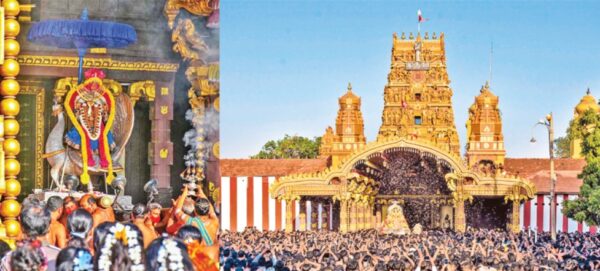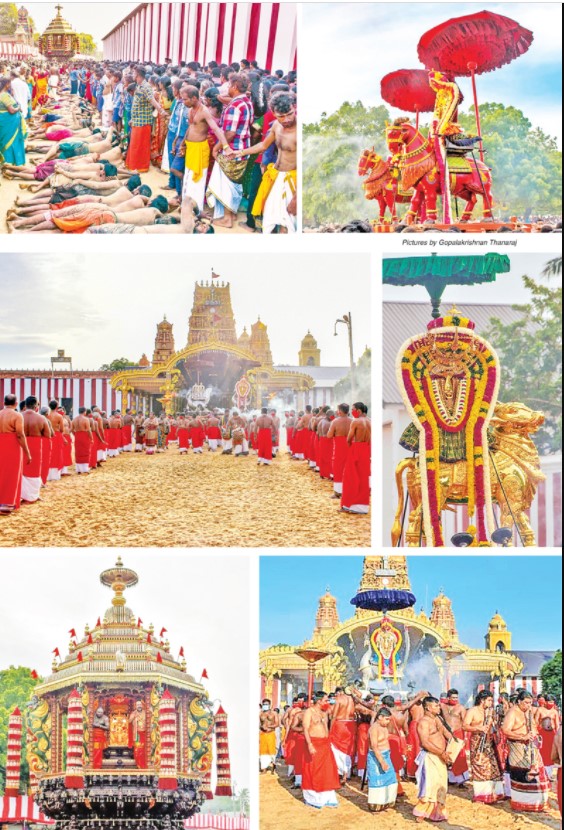
Source:Dailynews
The iconic landmark of Jaffna is the Nallur Kovil. It has been a Hindu bastion for centuries, respected by all communities in Sri Lanka. The Northern Province is embellished with so many Hindu kovils. In this vast domain of palmyrah trees, devotion to Hindu deities has dominated the lifestyle of the Tamil speaking community for centuries. The Nallur Kovil is definitely the most visited Hindu sanctum in the entire province. The month of August is synonymous with the famous festival that takes place in this kovil, often lasting for nearly two weeks.
This magnificent celebration of religion and humanity has surpassed our borders and begun to attract Hindu devotees from around the world. This year, after the impact of Covid-19 on mass religious gatherings, the grandeur of this vibrant Hindu festival will be somewhat restricted. As a Christian visitor to this kovil and her festivals it is worth remembering the history and traditions associated with this inspiring Hindu festival. I am reminded of a quote from the Bhagavad Gita “The peace of God is with them whose mind and soul are in harmony, who are free from desire and wrath.”
Ancient Ceylon was a multi-religious oasis, and once boasted of pancha ishwaram – the five kovils dedicated to Shiva along the coastal regions. Naguleswaram in the North, Ketheeswaram in the North West, Koneswaram towards the East (Trincomalee), Munneswaram located on the West (towards Chilaw) and Thondeswaram situated in the South. This bears testimony to the Hindu communities that once thrived here, before the invading Portuguese went onto destroy the cultural foundations of these ancient communities.
The Nallur Kandaswamy Kovil remains as an enduring icon of Tamil culture. For decades, this kovil has been a sanctum where devotees gathered in their thousands. Inside we can observe the depiction of Murugan, the god of war. Murugan is venerated as he makes manifestation in the form of the vel (chariot).
According to history, a kovil was built by Puvaneka Vaahu, a Chief Minister of Kalinga Magha. This is substantiated by the records of the Yalpana Vaipava Malai, a chronicle written in 1736 by the poet Mailvagana Pullavar. The ruler of Jaffna, Kalinga Magha supported the building of the kovil. The capital of Jaffna moved from Karanthodai (Vallipuram) to Nallur and Pooneryn over the centuries. Years later, King Kanagasuriyan regained this area and administered the kovil. The prospering domain of Nallur was once the capital of Jaffna’s rulers when the rajadhani was built with four gates, with a temple at each gate, to invoke divine blessings upon ancient Ceylon and all her citizens. The four kovils were Veyilukantha Pillayar Kovil in the East, Veeramakali Amman Kovil in the West, Kailaya Vinayagar Kovil in the South and Sattanathar Kovil facing the North.
A display of faith
The Hindu adherents of the Northern Province remained faithful and in 1734, work began with eagerness to restore the Nallur Kovil, which was being built for the fourth time, during the reign of the Dutch. The daunting task was accepted by Ragunatha Mudaliyar who worked at the kachcheri. The present land was commonly known as Kurukkal Valavu (Garden of the Priests). It is said that Krishna Aiyar became the first incumbent priest. The seventh custodian of the temple, Arumuga Mapaana Mudaliyar worked tirelessly to upgrade the kovil. He built the first bell tower in 1899. The fortified wall which demarcates the large kovil was built by him in 1909. Kumaradas Mudaliyar, the tenth custodian, is credited with restoring this kovil to its present position as the largest Hindu kovil in Sri Lanka.
I have visited Nallur Kovil on many occasions to understand the rich culture and traditions that it holds. The tranquil aura around the kovil is beautiful. I walked inside this amazing edifice, and saw four gopurams and six bell towers. By tradition, all males must remove their shirts before entering the kovil.
The variegated designs on the ceiling are brilliant and Dravidian forms of architecture originating from South India are evident. Ancient temples were built with sandstone and granite. The Vastu Shastra describes in much detail about building temples with emphasis on spatial geometry. Every kovil has a garbhagriha (Sanskrit for ‘womb’) – the innermost sanctum – where the statue of the primary deity is venerated. The southern side has a pond and garden.
The temple has shrines for Ganesh, Vairavar and Sooriyan. Kandaswamy Kovil incorporates the iconography of Hindu cosmology. The Vedas depict time in four epochs (yugam). The old Tamil word koyil (residence of god) is today used as kovil. Hindu temples have their boundary wall painted in red and white. The white stripes indicate sattva guna (goodness and harmony) and red stripes indicate raja guna (passion and confusion). It is painted in this manner to remind the devotee that one must overcome life to be enlightened. As the Bhagavad Gita teaches us, “Hell has three gates: lust, anger and greed.”
The festival in August
The Maha Raja Gopuram rises on the Northern skyline. It is a commanding nine-storey tower adorned with many intricate statues. A gopuram is a monumental tower at the entrance to a kovil and is topped with a kalasam, a stone finial. The temple tower reaches to the sky seeking divine union. Sri Lankans of all religions know the splendour affiliated with the festival of the Nallur Kovil in August, when multitudes of devotees gather. I had to gently push past people to get a closer look. Some were immersed in forms of penance, enduring physical pain. This is a reflection of their personal belief.
The fragrance of jasmine flowers and burning incense permeated the air. The ceremony begins with the ancient ritual of kodiyetram (hoisting of the flag). This ritual is set to take place on August 13 this year, as per the kovil’s festival calendar.
The orange hue of the flag symbolizes the sun, which dispels darkness and the saffron shading depicts fire, which is an unblemished purifier. The colourful festival laden with much pomp and tradition dominates the Northern peninsula for almost 25 days.
I saw a melange of poojas – pooja in Sanskrit means ‘reverence and adoration’. Commencing annually at 6.15 am, the flamboyant Ther thiruvila (festival of the chariot) is the highlight. Devotees venerate the simmasanam (silver throne) where the deity Shanmuhar and his consorts are placed. A group of pious men are attired in saffron clothes, a colour that symbolizes renunciation. Another verse from the Bhagavad Gita comes to mind, “The key to happiness is reduction of desire.”
Joyous chants of aro-hara resonated around the kovil premises. A devotee explained that the phrase appeals to God to remove all evil. The pulsating drumbeats at the festival were almost deafening. The silver throne is reverently carried on the shoulders of hundreds of worshippers, amidst an oblation of flowers. The Vel Vimanam is set to begin on September 2. The heavy ropes of the chariot were pulled with zeal. I felt lost within this ocean of devotees. The chariot festival (ratham) is expected to start on September 6 this year. The commitment of the devotees was awesome. This kovil draws all Sri Lankans together. It is a sanctum that generates reconciliation and acts as a cultural gateway for those who desire to understand Tamil and Hindu culture. The Vairavarshanthi ritual will conclude the festival on September 8, bringing this year’s religious observances to an end. As the Atharva Veda emphasizes, “Character is wealth. Good conduct is wealth. Spiritual wisdom is wealth.” The Nallur Kovil festival will continue for decades to come, shining her spiritual beacon upon our nation. To love without condition and give without expectation, that is the true spirit of love.







